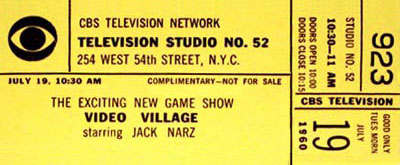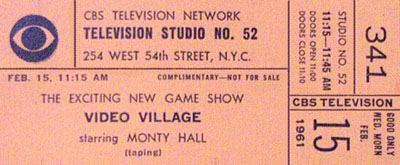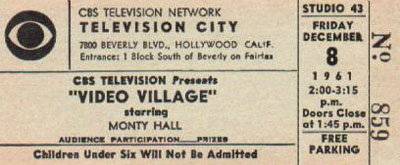Video Village



Game shows of the MTV generation usually look for physical player involvement, so I’m surprised no one has thought to revive Video Village, a silly but fun series that ran from 1960 to 1962 on CBS daytime, with a brief foray into prime-time hours. Format-wise, it was pretty simple: Two players competed as life-size “pieces” on a studio-sized game board. Each would bring a friend or relative along to roll the dice for them and, based on that roll, contestants would move one to six spaces along the “street.” Some spaces paid little prizes — merchandise or money — while some spaces cost you a turn or took your prizes away. On the last of the three “streets,” the prizes became considerable…and, of course, the object of the game was to reach the finish line before your opponent.
There was also a kid’s version of the show briefly on Saturday morning. As I recall, it was called Video Village Jr. in the TV Guide and it was called Kideo Village on the show itself — or perhaps it was the other way around. I was ten at the time and bothered more than anyone should have been by this discrepancy. Years later, when I met Monty Hall, I saw my chance to finally get this age-old riddle answered and off my widdle mind. I asked him why the show had one name in TV Guide and another on the air. His reply was, “It did?” Thank you, Monty Hall. (In 1964, the same production company, Heatter-Quigley, did another kids’ version of Video Village. This one was called Shenanigans and was hosted by Stubby Kaye.)
As you can see from the tickets above, the first host of Video Village was Jack Narz and the show was done in New York. Mr. Narz then had a home and marriage in Los Angeles and both were breaking up due to his being on the opposite coast so much. As the story is told, he begged CBS to move Video Village to Hollywood and they said this was not possible…so he quit. He departed so abruptly, in fact, that the production company had to scramble to find someone to host the next day’s show. They got Monty Hall, who had never seen the program, but he learned it well enough to take over for a few weeks. There was talk of letting him keep the job but some high exec at CBS owed a favor to a performer named Red Rowe, who had drifted about their schedule, hosting various talk and game shows. Rowe took over for a while but he didn’t work out and Hall was brought back for the rest of the run.
As one can also note above, the show was done in New York at CBS’s Studio 52, which was one of their busiest. It was broadcast live when Mr. Narz was the host and it must have been a pain to put up that huge set every morning and then strike it so that something else could be done on that stage later in the day. They went to taping five a day at some point during Monty’s tenure but things still got so crowded in the various Manhattan facilities that CBS did what they’d told Jack Narz they couldn’t do: Move the show to Los Angeles. The final months were taped at Television City in Hollywood and while he was out here, Monty set up a production company and sold his first show, Your First Impression, to NBC. Other programs, including Let’s Make a Deal, would follow.






